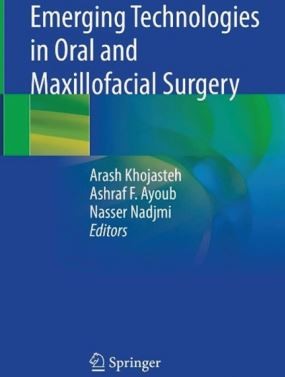Editors: Arash Khojasteh, Ashraf F. Ayoub and Nasser Nadjmi; 2023; Springer Singapore; £109.99 (hardcover); pp. 375; ISBN: 978-981-19-8601-7

The first edition of Emerging technologies in oral and maxillofacial surgery provides a detailed guide for surgeons and professionals in related fields. It covers the integration of advanced technologies such as 3D printing, virtual reality, augmented reality, artificial intelligence, and machine learning in oral and maxillofacial surgery practices. The book is expertly crafted, with organised chapters and high-quality flowcharts and figures throughout.
Divided into 18 chapters, this book provides a comprehensive journey from theoretical foundations to the practical application of advanced technologies in dentistry. In the initial chapter, the transformative impact of advanced technologies, including CAD/CAM, robotic surgeries, and regenerative dentistry applications, is discussed. The following chapter delves into the use of CBCT and MRI for computer-assisted maxillofacial treatments, offering clarity on surgical sites.
Moving forward, the third chapter focuses on the application of CBCT and MRI data in CAD/CAM, machine learning, and artificial intelligence. The next chapter classifies cutting-edge additive manufacturing techniques into extrusion- and fusion-based technologies. The fifth chapter explores rapid prototyping models that aid surgical planning, providing valuable pre-surgery simulations.
The sixth chapter discusses bone contouring in the reconstruction of facial defects using computer-designed patient-specific implants. In Chapter 7, the focus is on patient-specific implants produced by CAD/CAM for functional mandibular bone replacement. The next chapter explores the use of tissue engineering and 3D printing for bone regeneration.
Chapters 9-11 delve into in situ bone regeneration, recent advances in orthognathic surgery, and facial cosmetic surgery, respectively. The twelfth chapter emphasises the importance of custom-made dental implants for optimal oral rehabilitation. Chapter 13 explores the advantages, such as precision enhancement, and limitations, such as cost and size, of robotic surgery.
Chapter 15, serving as a valuable resource for individuals keen on understanding the fundamental principles of AI, along with Chapter 16, collectively define and introduce applications of artificial intelligence and machine learning in maxillofacial surgery. The subsequent chapter explores the performances and potential of artificial intelligence in precision medicine, tissue engineering, 3D and 4D printing, and robotic surgery, particularly when integrated with oral and maxillofacial surgery.
In Chapter 17, the focus is on bioprinting in maxillofacial surgery, utilising bio-ink for tissue scaffolds and addressing conventional printing issues. The last chapter explores the application of bioreactors in oral and maxillofacial surgery.
Overall, this book is a valuable resource, providing a comprehensive overview and practical insights into the latest advancements in the field, making it essential for professionals adopting these technologies in surgical practice.
Author information
Authors and Affiliations
Corresponding author
Rights and permissions
About this article
Cite this article
Mehrabanian, M. Emerging technologies in oral and maxillofacial surgery. Br Dent J 235, 856 (2023). https://doi.org/10.1038/s41415-023-6611-1
Published:
Issue Date:
DOI: https://doi.org/10.1038/s41415-023-6611-1
